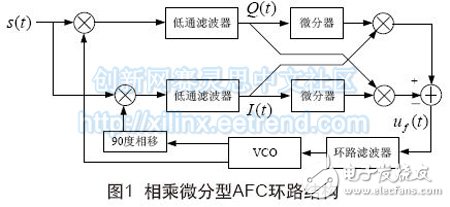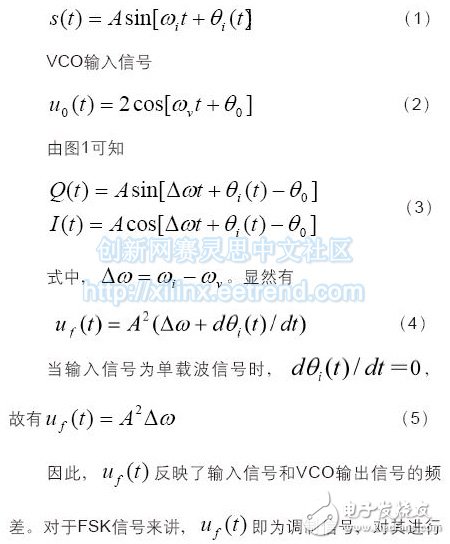Abstract: The principle of multiplying differential AFC ring demodulation FSK signal is introduced, and the control model of loop is analyzed. Using the modular design idea, the multiplicative differential AFC loop is designed by VHDL language, and the design method of key components is expounded. The AFC ring was implemented on the Xilinx FPGA device XC3S200-4FT200, and the simulation test was carried out using Modelsim6.0 software. The simulation results show that the loop works stably and meets the performance requirements. FSK (Frequency Shift Keying) is a relatively early modulation method after ASK (Amplitude Shift Keying). Due to its strong anti-fading ability, FSK has been widely used in the transmission of some fading channels [1]. In recent years, digital frequency modulation technology has developed considerably. CPFSK (ContIn Phase Frequency Shift Keying), under the condition of modulation index h=0.7 and coherent detection and delay decision, the power and frequency band utilization can achieve BPSK (Binary Phase Shift Keying). Keying) Good 1dB level. MSK (Minimum Shift Keying) is equivalent to 4PSK in terms of power and frequency band utilization, and its spectral characteristics are superior to PSK signals, and have been adopted in digital satellite communication systems [2]. There are many demodulation methods for FSK signals, which can be divided into two types: coherent demodulation method and non-coherent demodulation method. The coherent demodulation method refers to a demodulation method that needs to acquire a coherent carrier signal, and the non-coherent demodulation method does not need to acquire a coherent carrier before demodulation. From the anti-jamming performance, the coherent demodulation method is the best, but it is difficult to extract the coherent carrier from the FSK signal. The implementation technology is relatively complicated and requires a lot of hardware resources. Therefore, non-coherent demodulation is often used. An optimal non-coherent demodulator structure given in [1], the required signal-to-noise ratio is only 1~2 dB higher than the coherent demodulation method under the same bit error rate. There are many types of non-coherent demodulation methods, such as FFT-based spectrum analysis [3, 4], adaptive filtering based demodulation [5], differential detection algorithm [6], AFC (AutomaTIc Frequency Control, automatic frequency control). ) Ring demodulation method, etc. In recent years, with the development of programmable logic devices, digital systems such as signal demodulation using FPGAs have a series of advantages such as fast speed, flexible use, and programmable configuration, and have gradually become the first choice for the design and implementation of digital communication systems. This paper mainly discusses the principle of multiplying differential AFC ring demodulation FSK signal and FPGA (Field Programmable Gate Array) implementation method. The AFC loop is a negative feedback system. From the circuit structure, the AFC loop has three main structural forms [7]: multiplicative differential, delayed cross product, and discrete Fourier transform. This article only discusses the widely used multiplicative differential AFC loop. The structure of the multiplicative differential AFC loop is shown in Figure 1 [7]. If there is a frequency difference between the received signal and the local oscillator signal, there must be a phase difference within a certain time interval, and the phase error signal outputted by the phase detector is differentiated to obtain an error signal reflecting the frequency difference, and the signal is smoothed by the loop filter. After that, the oscillation frequency of the VCO (Voltage Controlled Oscillator) is approached to the input signal frequency, and finally the frequency difference is approximately zero. Input signal The filtering decision can complete the demodulation of the FSK signal. It can be known from the working principle of the multiplicative differential AFC loop that the AFC loop is a frequency negative feedback system, and the frequency control model of the AFC loop shown in FIG. 2 can be obtained. In the loop, the output voltage of the discriminator is proportional to the frequency error signal. For the phase-locked loop commonly used in wireless communication, the output signal of the VCO has an integral relationship with the phase signal, and the voltage-controlled oscillator is an inherent integral link in the phase-locked loop [9]; in the AFC loop, the VCO The output signal is proportional to the signal frequency, and the loop no longer has an integral link. Therefore, the entire AFC loop is not a second-order linear system, but a simpler first-order linear system. The working process of the AFC loop can be analyzed using a general first-order linear loop model. According to the working principle of the first-order linear loop [8], the condition of the loop lock is that the loop gain K must be greater than the natural frequency difference Δω, and the larger the loop gain, the shorter the capture and lock time. It can be seen from Fig. 2 that the loop gain is composed of the discriminator, the filter and the VCO gain. The method of controlling the total gain of the loop is flexible, and the total gain of the loop can be improved by increasing the gain of any link in the loop. the goal of. Explosion Proof Motor,Explosion Proof Servo Motor,Exproof Motors,Explosion Proof Ac Motor Yizheng Beide Material Co., Ltd. , https://www.beidevendor.com

